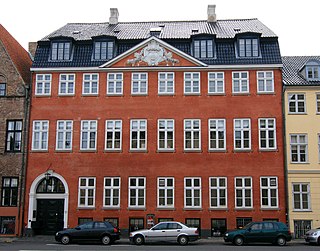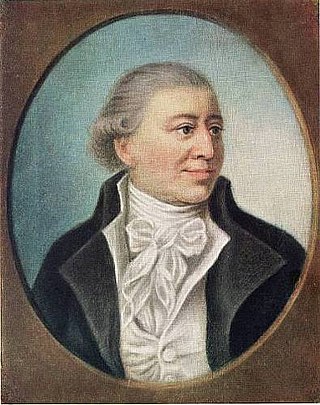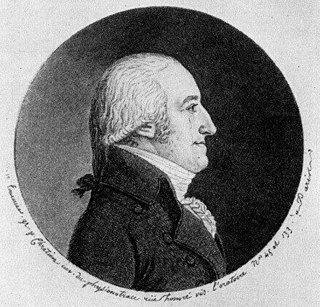
Marienborg, a mid 18th-century country house perched on a small hilltop on the northern shore of Bagsværd Lake, Lyngby-Taarbæk Municipality, 15 kilometres (9.3 mi) north of downtown Copenhagen, has served as the official residence of Denmark's prime minister since 1962. It is frequently used for governmental conferences, summits and other official purposes, including the prime minister's new year speech. Unlike the residences of many other heads of government and state, Marienborg does not serve as the government headquarters or contain the office of the prime minister. The Prime Minister's Office is instead located in Christiansborg on Slotsholmen in downtown Copenhagen. Marienborg was listed on the Danish registry of protected buildings and places in 1964.
Events from the year 1783 in Denmark.

Rosenfeldt Manor is a manor house and estate located just west of Vordingborg, Vordingborg Municipality, some 90 km south of Copenhagen, Denmark. One of 12 new manors created when Vordingborg Cacalry District was dissolved in 1774, its first owner was Reinhard Iselin. The current main building was constructed for Oscar O'Neill Oxholm in 1870 to a design by Henrik Steffens Sibbern.

Store Godthåb is a former late 18th-century country house in the Frederiksberg district of Copenhagen, Denmark. It is located on Godthåbsvej, which is named after the property, just west of its intersection with Nordre Fasanvej. The main building, a former barn and a third building were listed on the Danish registry of protected buildings and places in 1954.

Johan Frederik Classen, frequently also J. F. Classen, was a Danish-Norwegian industrialist, major general, landowner and founder of Det Classenske Fideicommis. He served as chancellery adviser to King Frederik V. Classen built the manor house Arresødal in 1773, he renovated the Neoclassical manor house Corselitze in 1777, and built the General's Summerhouse by the Corselitze Forest.

The Behagen House is a Neoclassical townhouse located at Strandgade 26 in the Christianshavn neighbourhood of Copenhagen, Denmark. The building was listed on the Danish registry of protected buildings and places in 1918.

Gysbert Behagen was a German-Danish merchant, ship owner and director of Danish Asia Company. His home at Strandgade 26 in the Christianshavn neighbourhood of Copenhagen is known as Behagen's House after him.

Michael Fabritius was a Danish merchant, shipowner and shipbuilder.

Reinhard Iselin was a Danish merchant, shipowner and industrialist who founded Reinhard Iselin & Co. in Copenhagen in 1749. The company completed 65 expeditions to the Danish West Indies. Iselin was also active in the Danish Asiatic Company where he served on the board of directors from 1759 to 1769. He owned Iselingen and Rosenfeldt at Vordingborg. He was raised to the peerage with the rank of baron in 1776 but the title died with him since both his sons died as infants.

Peter van Hurk was a Dutch-Danish merchant.
Gotthilf Just Fabritius was a Danish merchant.

Gysbert Wigand Michelbecker was a Danish merchant, shipowner and property owner. He was one of the largest merchants in Copenhagen of his day and was from 1687 the owner of a large property at Frederiksholms Kanal in Copenhagen where the National Museum of Denmark stands today.

Danish Asiatic Company was a Danish trading company established in 1730 to revive Danish-Norwegian trade on the Danish East Indies and China following the closure of the Danish East India Company. It was granted a 40-year monopoly on Danish trade on Asia in 1732 and taken over by the Danish government in 1772. It was headquartered at Asiatisk Plads in Copenhagen. Its former premises are now used by the Ministry of Foreign Affairs.

Johan Leonhard Fix was a German-Danish merchant who served as Governor of Frederiknagore in Danish India. He moved to Copenhagen in 1787 where he served as director of the Danish Asiatic Company from 1791 to 1805. He was the third largest contributor to the rebuilding of Christiansborg Palace after the first Christiansborg Palace was destroyed in a fire in 1804.

Joost van Hemert was a Danish merchant, financier and shipowner. His trading house, Joost van H. & Sønner, founded circa 1740, was later continued by his son Peter van Hemert.

Conrad Alexander Fabritius, ennobled by letters patent under the name Fabritius de Tengnagel in 1778, was a Danish merchant, shipowner and patron of the arts. He owned Enrum at Vedbæk from 1776.

Pierre Paul Mourier was a Danish Asiatic Company trader who spent 15 years in Canton. He created a Danish-Chinese dictionary of more than 10,000 words. He owned Aagaard from 1787 to 1896.

Henrik Bolten was a German-born Danish merchant. In 1785, he was created a baron under the name von Bolten. His former home in Gothersgade is still known as Baron Boltens Gård-

Købmagergade 44 is the former headquarters of Holger Petersen's textile company in Copenhagen, Denmark. The present building on the site, which is from the 1880s, replaced the Royal Waisen House, a combined school and orphanagefor indigent children, which relocated to a new purpose-built school building on Nørre Farimagsgade. The institution's old building on Købmagergade was a former Baroque style town mansion from the 1740s, whose earlier residents included Russian envoy to Copenhagen Johann Albrecht Korff and businessmen Joost and Peter van Hemert. From 1971 to 2017, University of Copenhagen's Department of Theology was based in the building. It is now part of the Trinity Quarter, a mixed-use complex owned by Hines, with a 24-hour boutique hotel, retail and six residential apartments.

Abraham Schneider was a German-Danish businessman, industrialist and ship-owner. He owned Jonstrup Textile Mill in Jonstrup outside Copenhagen as well as the country house Store Godthåb in Frederiksberg.


















